If you're keeping an eye on digital marketing trends, it's no secret that video has become a more and more significant piece of the content marketing mix.
By the year 2020 video will account for 82% of all consumer Internet traffic, according to Cisco, so it's no longer optional for marketers to jump in and make some space for video content in their strategies.
In a digital world overflowing with content, video is one of the most effective ways to engage with audiences, since it can be a more digestible and personal form of interaction than written content. At the same time, there's a gradual shift away from over-edited glossy videos to unscripted, unedited sharing-the-moment videos that are way more sincere and authentic.
One of the best examples—winning the hearts of audiences everywhere—is live video.
Livestreaming is one of the most rapidly growing trends now, as it provides a way to share the experiences in real-time. Brands are actively incorporating live video it into their marketing strategies, and major social media platforms are aligning themselves with livestreaming.
Snapchat and Twitter-owned Periscope have been there for a while already. Facebook caught up with the trend in 2016 with Facebook Live, and Instagram has also released a livestream broadcasting feature.
A highly valuable characteristic of live video is how versatile it is, allowing you to experiment with diverse types of content at relatively low cost.
So, this article will provide tips and tricks at how you can use video livestreaming—and do it right.
1. Live Interactive Tutorials and Q&As
Marketing isn't solely about selling your products; it's also about showing your customer how helpful you can be, thus generating loyalty to the brand and provoking interest around the topic you cover.
One of the best ways to use live video for those purposes might be to run a live show that is both entertaining and educational—an interactive lecture or a live how-to demonstration. As an added personal touch, and to entice viewers back, you can suggest viewers brainstorm future topics to cover in the comments section.
A good example is the Office Hours hangouts broadcast by the Google Webmaster team. Once in a while, users are invited to join live to discuss webmaster topics and get questions answered by all kinds of experts joining the hangouts. The sessions are announced and questions collected through social networks in advance; once the hangout starts, the host invites viewers to jump in to make comments and share thoughts, which makes the video experience interactive.
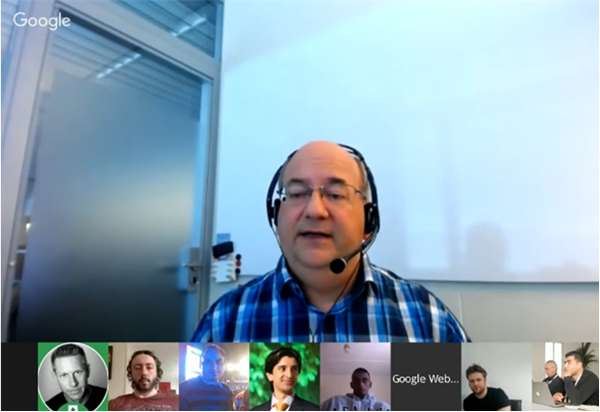
Some tips:
- Have a plan, but be flexible. Have a specific point to cover, but don't overthink it ; leave some space for user-contributed suggestions and questions. Be personal and helpful, and do your best finding a balance between delivering and interacting.
- Practice. Facebook Live, for instance, allows running a private live session, visible to you only. Simply adjust your privacy settings to Only Me before you tap the Go Live button—a great way to get camera-ready before going live in front of viewers.
- Prepare a schedule. Routine can help grow an audience. People get in the habit of watching the show at a certain date and time, and they'll know when to come back to hear about the topics they've suggested you cover in the future.
2. Live Events
Fully two-thirds of B2B marketers use in-person events as a part of their content marketing strategy, according to research from the Content Marketing Institute and MarketingProfs. Digitell's experience has been that up to 35% of people who watch a livestream of an event attend that event in person the following year.
Streaming an event (whether a music festival or a conference) can be a fantastic way to attract new audiences despite distance and other obstacles, and build a worldwide online community around the event. It's also a great opportunity to reach Millennials if you provide the content using new technologies they are so comfortable with.
An inspiring example is Coachella, an annual music and arts festival held in California, livestreamed in 2011 for the first time: The tickets to the event got sold out in three days in 2011 (before it was livestreamed)—and in three hours the year after. In 2016, while daily in-person attendance was close to 100,000 people, it attracted around 9 million live viewers in total.
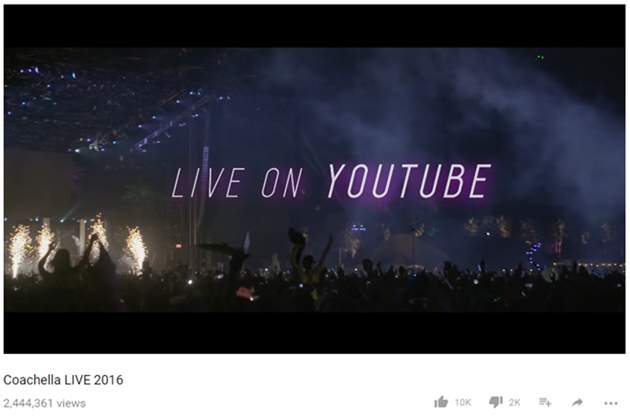
Live video may be an even better fit for smaller events, which quite often have capacity limits. Live-streaming is a handy way to expand the capacity beyond the venue, while in-person participants still get the intimate experience of attending a closed event.
Some tips:
- Promote beforehand. Make sure to spread the word about the upcoming event beforehand; promote it across all social networks, and provide the approximate streaming schedule.
- Count down and mind the buzz. Start a countdown in your social profiles to remind followers of the start date. Come up with a catchy hashtag, use it every time you post anything about the event, and encourage your followers to take it over: Doing this will hugely help you collect feedback later, but it may also allow you to evaluate expectations before the event and clarify whether there's anything you need to rethink.
- Make it accessible, by all means. Make sure to find a proper time to livestream. Obviously, not all viewers across the globe will be able to fit your livestream into their schedules, but try detecting the time zone of the major part of your audience, and a convenient timeframe for them to join you live. In the same way, analyze which of the social networks offering live video streaming is the most popular and accessible among your potential viewers, and use it if possible.
- Let online attendees participate a bit. Allow participation if it fits into the event format. For instance, if you are streaming a conference that has a Q&A session with speakers after each talk, think of a way to bring up some of the user-contributed questions from the live comments.
- Do a bit of post-production work. In some networks (Facebook and Periscope), the video you've streamed will stick to your profile and may reach even a wider audience afterward, so you may also think of doing a moderate amount of post-production: Add an attractive description, or cut out the dead moments to make the experience as great for the later viewers.
3. Interviews and Discussions
An entertaining and useful way to use livestreaming is to host live interviews and discussions.
Invite an interesting guest or an influencer in your niche (to your studio or remotely) to cover a hot topic, share stories, or discuss current news. Allow users to ask questions along the way and pick up the most interesting ones occasionally during the discussion (or in the end, if it's an interview your livestreaming). If there's a danger that the show is becoming too promotional or company-centered, a great way to shift the focus to real people would be to arrange short, candid interview sessions with team members or customers (a brave move!).
A good example is the show streamed live, twice a week, by Live Streaming Pros. Occasionally, the hosts invite a guest to share an experience, a strategy, or proven tips. At the end, user-contributed questions are answered. A nice tip from Luria Petrucci, who hosts the show: Try not to rush while everybody is joining the livestream; begin with a kind of "question of the day" while monitoring the arriving viewers (and first answer it yourself to win some time, as the comments may display with a slight delay).
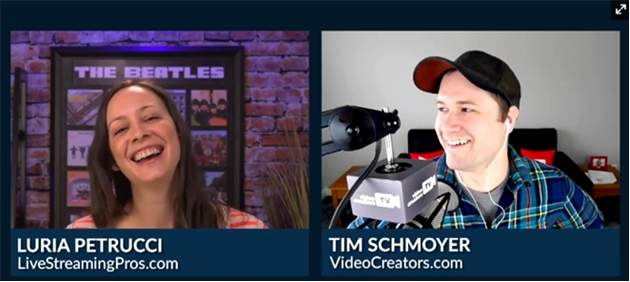
Some tips:
- Promote and tease. Share some info about the guest who will be joining you, and drop hints about the important topic you'll be discussing.
- Prepare. This is not about producing polished webinars; still, you should have a plan in mind about how to structure the conversation and which questions to ask your guest.
- Involve the viewers. Again, integrate questions from viewers into the discussion, or address questions at the end of the show (make clear that's when you'll get to them). Address viewers by name when referring to their questions.
4. Announcements and Live Launches
If there is exciting company news to share, an announcement to make, or a new product to launch... you can of course share the news with a press-release, on your website, and through social networks. However, if you livestream this kind of content, you will make viewers feel that you care about them enough to announce the news "personally" and therefore build in-the-moment excitement.
When launching a product, for example, you can reveal the details gradually and offer the viewers the intimate experience of seeing it first. If opening a store, you can share with the audience the step-by-step process it took to reach your goal, sharing unhappy and happy moments, and drawing in viewers and building a relationship with them along the way.
You can sum up the livestream with a live Q&A session to hear immediate feedback and cover the most pressing questions.
Adobe took this approach in 2015 with a 24-hour Periscope session to release its new product, Creative Cloud, and to share the excitement and its "vision for a connected creative process." Apart from discussing new features, the main idea of the broadcast was to let viewers engage with the teams behind the product and ask any questions in a chat with 24 different team members—a great way to add the personal touch to the presentation!
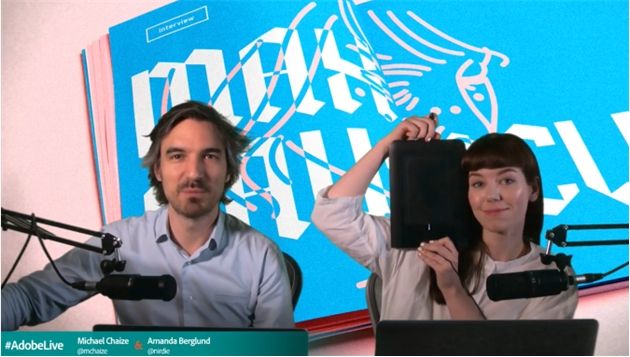
Some tips:
- Tease. Reveal details bit by bit, provide a teasing overview, but leave some space for curiosity by not giving away too much info.
- Offer something special. Use live video to announce a special offer for your consumers; provide an exclusive special for viewers/online community.
- Involve. Once people know you pay attention to their feedback, and once they feel involved and see the real efforts you've made behind the product, it will be of much higher perceived value to them.
- Embrace the comments. While streaming, keep a balance between delivering the news and reacting to the comments and questions.
- Show gratitude. Take a moment to thank your audience for coming along with you.
5. A Peek Behind the Scenes or at Company Culture
Nowadays, video is one of the best formats for storytelling, so it can be a great way to humanize the brand and make people feel they can relate to it. It can shed light on big companies that seem to lack transparency, and it can let consumers explore areas often inaccessible to the public.
Sharing company culture is a fantastic opportunity to break down the walls between a company/brand and its customers, helping to establish a more genuine connection.
Live video allows you to invite the audience to be your digital guest, and show viewers around your office; giving a sneak peek into how you get your work done is a proven way to engage.
Perhaps the most well-known example is General Electric, which started using Periscope to boost transparency and provide a behind-the-curtains look at the corporation. During "Drone Week," the company shared a drone's-eye view of its manufacturing facilities and machinery at GE sites across five different industries. The questions and comments followed the livestream itself and via the #droneweek hashtag in other social networks. According to Sydney Williams, global digital marketing manager at GE, the program was a huge success, so GE is planning on doing it again in summer 2017.
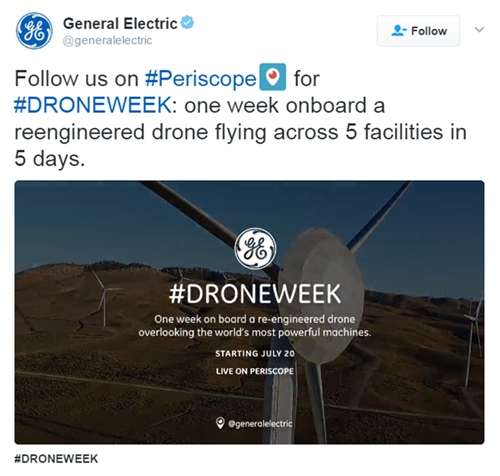
Some tips:
- Promote. Yet again. Frame it as a personal invitation to be your guest.
- Ask for feedback in advance. Collect the feedback before broadcasting; pay attention to what exactly the viewers are willing to see (company's workspace or tools, the process of baking the cakes you sell, or members of the team). Ask viewers to prepare questions they would like to ask about your company.
- Be personal. If possible, greet the viewers arriving to your stream by name, and try answering the most interesting questions as honestly as you can.
- Include a call to action. Unobtrusively remind the viewers of other ways to engage and follow your company through social networks for even more interesting content.
The Outcome
"Afterlive" is as important as your actual in-the-moment, live video, so a common tip for any type of livestreaming would be analyze the results!
It would be a real time-saver to use a social-media listening tool (like Awario) to gather and systematize the feedback. Moreover, to react to the feedback right-away, retweet and repost best user quotes to your company social profiles. And mark the most constructive comments to help you revise and improve your process.
Live video is making its way to people's screens more and more, so it's high time to find your own way and make use of the trend—especially if you're ready to think outside the box and to open the door to live feedback and new, genuine connections!




